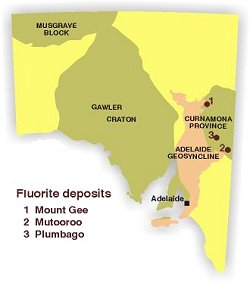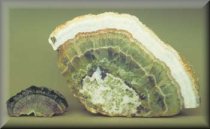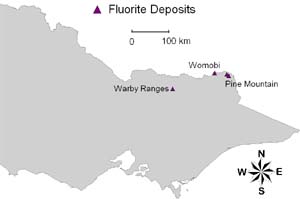|
|
Informations about Fluorite in Australia.
![]()
Fluorite (calcium fluoride, CaF2), known commercially as ‘fluorspar’,
is the principal source of fluorine and fluorine chemicals, including
the important industrial chemicals hydrogen fluoride (HF) and hydrofluoric
acid (70% HF). A large range of fluorine-containing chemicals (CFCs, HFCs
and HCFCs) are used as industrial solvents, refrigerants, aerosol propellants
and plastic foams. Synthetic cryolite (Na3AlF6) is used as an electrolyte
for smelting aluminium metal. Ceramic-grade fluorspar is used in decorative
glassware and enamel, and metallurgical-grade fluorspar is used as a fluxing
agent in the steel industry.
World production is ~4 Mt/year, but declining use of CFCs and more efficient
usage in the steel and aluminium industries is reducing demand.
All
of Australia’s requirements are imported.

The only
commercial production of fluorite in South Australia has been from very
small vein deposits in the Olary region. Fluorite was produced for the
steel and glassware industries from two deposits within 1 km of Plumbago
homestead, 40 km north of Manna Hill. Over 580 t were mined during 1932–36,
and 110 t in 1956–58. Veins within metasediments of the Willyama
Supergroup are up to 1 m wide and consist of quartz and purple fluorite.
At Mutooroo, 40 km south of Cockburn, a swarm of veins containing quartz,
purple fluorite, calcite and barite occur within Adelaidean metasediments.
The 55 t mined in 1970–71 exhausted this deposit.
Numerous
other small occurrences are known in the region. Narrow veins of green
and purple banded fluorite occur within granitic breccia near Mount Gee
in the Mount Painter area.

Banded fluorite with a drusy quartz coating, Mount Gee area.
Additional Reading
Olliver, J.G., 1976. Fluorite in South Australia. In: Knight, C.L. (Ed.), Economic geology of Australia and Papua New Guinea, 4, Industrial minerals and rocks. Australasian Institute of Mining and Metallurgy. Monograph Series, 8:141-142.
------------------------------------------------------------------------
PIRSA Home
Page URL: http://www.pir.sa.gov.au/minerals/geology/commodities/fluorite
Page Last Modified: October 31, 2007
![]()
Roger Buckley, Melbourne
Updated: April 2007

Fluorite is rare in Victoria, with only a few small deposits recorded.
The only known production is from Pine Mountain near Walwa in northeast
Victoria.
Other localities are Sandy Creek near Walwa, the Warby Ranges near Wangaratta,
and the Womobi Wolfram mine at Thologolong. Fluorite is used as a metallurgical
flux, as a source of fluorine in the manufacture of chemicals, and in
ceramics.
For more information, refer to Victoria's Geology and Industrial Minerals
and Rocks of Victoria.
The previous version of this Information Note was published in March 2003.
The advice provided in this publication is intended as a source of information only. Always read the label before using any of the products mentioned. The State of Victoria and its employees do not guarantee that the publication is without flaw of any kind or is wholly appropriate for your particular purposes and therefore disclaims all liability for any error, loss or other consequence which may arise from you relying on any information in this publication.
Fluorite
Roger Buckley, Melbourne
Updated: April 2007
MNI0007
ISSN 1443-3567
For more information, refer to Victoria’s Geology and
McHaffie, I.W. & Buckley, R.W (1995) Industrial
Minerals and Rocks of Victoria, Geological Survey of
Victoria Report 102.
![]()
![]()